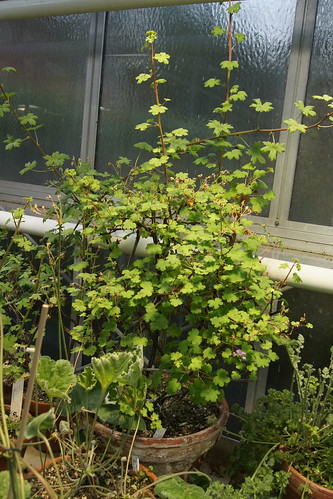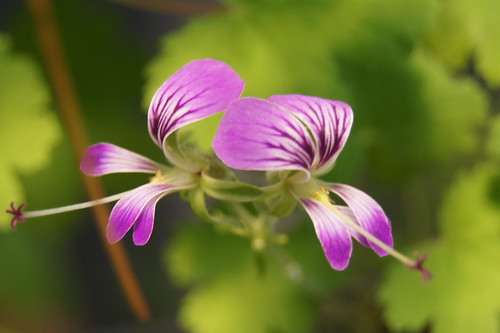Propagating Pelargonium antidysentericum
Morris B., Propagating Pelargonium antidysentericum, The Geraniaceae Group News, Summer, 2013, p. 14.
Pelargonium antidysentericum (sect. Jenkinsonia, see POSA-2:7) is a curious species with a ground level tuber-caudex from which a tangle of thin perennial stems emerges… For the last few years, I have propagated P. antidysentericum, and other thin-stemmed Pelargonium species, in water. While the plant is in growth, I snip off piece3s of stem about 10 cms long.
I use baby food jars covered first in a layer of brown paper to keep out the light and prevent growth of algae, and then a layer of silver foil to prevent over-heating. I use tap water or filtered rainwater, with a pinch of "Miracle Gro" fertiliser per litre. I add enough water to each jar so that at least 1 cm of stem is submerged. The top of the jar is plugged with a 2 cm circle of foam rubber with a slit in it to support the twig.
A callus starts forming within a fortnight and roots appear soon after. When the root growth seems strong enough, pot up in moist compost and keep in the shade until you see signs of positive growth. One word of caution: do NOT use rooting hormone, the end of the twig will split due to an overgrowth of cells - this to be honest looks great BUT you will find that actual root production is retarded.
This technique is also useful with shrubby Oxalis gigantea, a species that is not the easiest to root.
Some years ago, Cliff Blackman (Australia) suggested I try leaf cuttings. I was incredulous to start with but discovered it could be done. This was using damp sand but I found the technique of rooting in water was even more successful, including for species from sect. Hoarea, and my Hoarea hybrids. The leaves root up easily from the base of the petiole (as long as you do it early in the growing season); after potting up, the shoots will appear within six months. I have also used the LED boards (see TGG News Spring, 2012, p.7) successfully to give extra light for propagating from the leaves of Winter-growing species.
The advantage of these propagation methods is first of all that I know all the progeny are true to the parent taxon and of course this is the only way to propagate the lovely sect. Hoarea hybrids I have; the impossibility of propagating these hybrids from seed and the difficulty of vegetative propagation has always been the reason they die out of cultivation.

P. antidysentericum. Ботанический сад Мюнстера (Munster Botanical Garden), Германия (Germany)



























